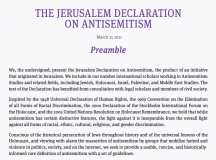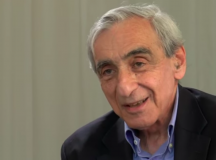Jeffrey Herf is Distinguished University Professor, Department of History, University of Maryland College Park. His latest book, Israel’s Moment: International Support for and Opposition to Establishing the Jewish State, is forthcoming from Cambridge University Press. He has played a prominent role in defeating BDS on US campuses. In this helpful review of the IHRA Definition of Antisemitism and the alternative Jerusalem Declaration he makes what many see as the essential criticism of the latter: in 2021, to argue that calling for the elimination of the state of Israel is ‘not antisemitic’ flies in the face of political realities. That said, he adds,we should remember that when BDS is defeated on campus it is because a majority of scholars conclude that the case for it rests on a foundation of falsehoods, not because it is antisemitic.
Background
In 1975 UN General Assembly passed a resolution declaring the Zionism was a form of racism. Though subsequently revoked, the accusation became a standard theme in international politics, one which placed supporters of the existence of the state of Israel on the defensive. Success in a debate framed in that manner meant that Zionism was not a form of racism, a formulation that was hardly a ringing endorsement of the Jewish state. Israel’s defenders saw the charge of racism as a form of antisemitism. In May 2016, an ‘intergovernmental’ organisation called the International Holocaust Remembrance Alliance or IHRA published a ‘non-legally binding working definition of antisemitism’ that formalized the retort by specifying ways in which denunciations of Israel amounted to forms of antisemitism.
Many governments, including that of Germany, subsequently adopted the IHRA definition, which covered hostile efforts such as BDS, the campaign to boycott, divest, and sanction the state of Israel. As a result, many academics, and supporters of BDS, especially in Israel and in Germany who were convinced they were doing so as part of a battle against racism and oppression, found themselves accused of participating in an antisemitic endeavour. Seeking to acquit themselves of that sin, on March 25, 2021, a group of liberal and left-leaning scholars in Jewish history, Holocaust studies and research on the Middle East, mostly in the United States, Israel, and Germany posted ‘The Jerusalem Declaration on Antisemitism.’ [Mathias Kuentzel has made this point effectively. See his ‘Aber irgendwie doch,’ Perlentaucherr: Das Multimagazine, March 30, 2021.] It is a revealing but not convincing statement.
Examining the IHRA Definition
Neither definition directly addresses the issue of whether various attacks on Zionism and the state of Israel are true of false. The IHRA definition assumes that they are while the recent statement implies that at least some are not. If Israel is the racist state described by BDS advocates, then it is not antisemitic to say so. But if it is not, then making such an accusation does indeed repeat the pattern of false accusation that has been a mainstay of the longest hatred. I explore these issues below.
Historians of antisemitism have long made the point that the establishment of the state of Israel in 1948, coming in the wake of the Holocaust, was also accompanied by a decisive moment in the history of antisemitism.[1] This was the case because Israeli sovereignty, including possession of the sinews of armed force and diplomacy, existed to defend the citizens of the Jewish state against the persistence of antisemitism, both in its Christian and then more secular Nazi forms as well as in Arab nationalism and in elements of Islamist politics. For reasons deeply embedded in long standing cultural traditions of pre-modern religious, and modern secular forms of antisemitism, Israel’s establishment created a new chapter in the history of what the late historian Robert Wistrich called ‘the longest hatred.’[2]
This was and remains the case because in the antisemitic imagination a sovereign Jewish state brought to reality fears and fantasies about the powerful and evil Jew that had been an element of Christian, Islamic and secular views of the Jews for centuries. That is why Israel’s victories in wars with the Arab states in 1948 and 1967, and against subsequent Palestinian terrorist campaigns were often followed by denunciations of Israel as a racist, imperialist, aggressive, settler-colonialist, and apartheid Zionist state. The hatred of Israel drew on much older patterns of prejudice. The weight of cultural and intellectual history suggests that it is plausible to see continuity between the old antisemitism that told lies about the Jews and the new antisemitism that tells lies about Israel.[3]
The IHRA definition of 2016 turned this plausibility into a certainty. The IHRA definition responded to the mix of leftist and Islamist attacks on Israel that were evidence of what Wistrich called the shift in antisemitism’s global ‘center of gravity’ from Europe to the Middle East and Iran. [On that shift, see Wistrich, A Lethal Obsession.] It brought the conclusions of years of scholarship about this shift to describe a new and important chapter in the history of the longest hatred. As the PLO and Palestinian Authority and their supporters in American and British universities were using the racism accusation to wage political warfare against Israel, the IHRA definition indicated that Israel and its supporters would go on the offensive by making the plausible accusation that at least some of its enemies with either driven by antisemitic intentions or whatever their intentions, made arguments that echoed classic antisemitism in new form. With that the gloves had come off. The IHRA definition presented those who presented themselves as opponents of racism to be instead the latest in a long line of bigots.
The authors of the IHRA authors included the caveat that ‘criticism of Israel similar to that levelled against any other country cannot be regarded as antisemitic,’ or, one could add, criticisms that are expressed on a regular basis in Israeli politics and public debate. That said, its focus was on attacks on Israel which the authors argued were either motivated by antisemitism, or regardless of motives, amounted to forms of antisemitic argumentation. Of its eleven examples of antisemitism, five existed before the establishment of the state of Israel. Seven addressed what the authors called the antisemitic aspects of attacks on Israel.
The IHRA authors wrote that accusing ‘the Jews as a people, or Israel as a state of inventing or exaggerating the Holocaust,’ and of being more loyal to Israel or Jews worldwide ‘than to the interests of their own nations’ as examples of antisemitism. They asserted further that ‘claiming that the existence of the state of Israel is a racist endeavour…applying double standards by requiring behaviour not expected or demanded of any other democratic nation…using the symbols and images associated with classic antisemitism (claims of Jews killing Jesus or blood libel) to characterise Israel or Israelis…’ and ‘drawing comparisons of contemporary Israeli policy to that of the Nazis’ were all forms of the new and contemporary form of antisemitism. The IHRA definitions were responses to accusations against Israel that had become common in world politics since the 1960s. Holocaust deniers in Europe, the United States, and the Middle East have accused Israel of inventing the Holocaust to foster undeserved international sympathy and to extort money from the German government.[4]
The comparison of Israel to Nazi Germany had been a staple of Soviet and PLO propaganda. At times, Holocaust denial illogically went hand in hand with what Wistrich called ‘Holocaust inversion,’ that is, accusing Israel of doing to the Palestinians what the Nazis had done to the Jews.[5] The dual loyalty charge, a familiar theme in Nazi propaganda and of the ‘America First’ movement in the United States in the 1930s surfaced again during the Iraq War when two left-of-center political scientists, one at Harvard and another at the University of Chicago, wrote that an ‘Israel lobby’ was responsible for that war.[6]
In his 2016 campaign for the Presidency, Donald Trump ran an ad in concluding his campaign that warned of dangerous global elites represented by prominent Jewish figures.[7] The examples in the IHRA definition, though present in the antisemitism of the far right, had been common in the ‘new antisemitism’ of the Soviet era and third world left of the late twentieth century, the PLO, and varieties of Islamist antisemitism from the Muslim Brotherhood, to Hamas, Hezbollah, and the Islamic Republic of Iran.[8] The accusations to which it referred were the themes scholars had described as the ‘new antisemitism,’ that is, one focused on Israel. In Britain in the Corbyn-era Labour Party, the issue of antisemitism was front and center because he and his supporters refused to distance themselves from Palestinian terrorist organisations at war with Israel.[9] In the US, however, where some of the most intense and important BDS campaigns took place in academic professional organisations and on university campuses, those of us who worked to defeat BDS-type resolutions did not base our opposition to BDS efforts foremost on the argument that they were part of an antisemitic campaign.[10]
Rather we asserted that the factual assertions that motivated the BDS campaigns were based on falsehoods, and historical distortions. We did note the unseemly preoccupation with the presumed sins of Israel, the comparative lack of interest in the sins of others, and the lack of attention to the terrorist attacks waged against Israeli civilians in recent decades. We offered contrasting factual assertions by the Israeli government and by journalists which disputed claims, for example, that the Israeli military intentionally targeted civilians or university buildings. When BDS resolutions were proposed in the American Historical Association, we did not accuse their advocates of antisemitism. Instead, we said that the resolutions were based on bad history, biased journalism, and fell far short of the standards of evidence expected from professional historians. We pointed out that BDS was a political campaign which inappropriately sought to use the prestige of professional organisations in order not to protest a particular policy of the Israeli government but to delegitimise it in the hopes of destroying it. Should that happen, we argued, the results would be further and likely extensive loss of life – at worst a second Holocaust. Serious scholars needed to think about the consequences of passing such resolutions.
In most instances, those who supported BDS in American academic organisations did not face accusations that their views constituted a form of antisemitism. At the University of Maryland, College Park, for example, where BDS resolutions were defeated on two occasions by the Student Government, students and some faculty pointed out that such resolutions were a political effort to break university and American government connections with Israel, a break that could have catastrophic consequences.[11] Both in the American Historical Association and at the University of Maryland, College Park, successful opposition to BDS efforts focused far more on issues to truth and falsehood, and on the consequences of adopting error-ridden resolutions than it did on the motives of those proposing them.
Examining ‘The Jerusalem Declaration on Antisemitism’
The JDA discusses antisemitism as a form of racism. While racism plays a role in antisemitism’s s long history, its most important sources lay in interpretations of Christianity as well as Islam that formed a template for modern secular Western tradition of antisemitism. These religious, not racial, antecedents of modern antisemitism receive no mention in the JDA definition.[12] The ‘Jerusalem Declaration’ includes five plausible examples of antisemitism regarding Israel, most importantly efforts to require Jews ‘because they are Jewish, publicly to condemn Israel or Zionism.’ However, the JDA authors do not include in their definition of antisemitism the key elements of the IHRA definition: blaming Israel for inventing the Holocaust, making accusations of dual loyalty, calling Israel a racist endeavour, applying double standards, applying symbols of classic antisemitism to Israel, or calling Israelis Nazis. That the JDA authors refrain from calling any of these examples possible forms of antisemitism is one of its significant shortcomings.
The core of the Jerusalem Declaration, its raison d’être, concerns examples that ‘on the face of it, are not antisemitic.’ Point eleven, for example, asserts that it is not antisemitic to ‘support Palestinian demands for justice and the full grant of their political, national, civil, and human rights, as encapsulated in international law.’ The issue here is the meaning of such demands. The BDS campaign has been quite clear that it regards the current state of Israel as incompatible with the realisation of Palestinian rights. The Hamas Charter is, even more emphatic that Palestinian rights and Islamic justice demand that the state of Israel be abolished. Though the JDA describes denying Israel’s right to exist as a form of antisemitism, the wording of this other clause opens the door to the view that in fact, it is ‘not antisemitic’ to call for the elimination of the state of Israel if doing so is necessary to fulfill, unspecified, Palestinian demands for justice. If it is ‘not antisemitic’ to do that, then the meaning of the word antisemitism is emptied of meaning.
Point twelve of the JDA asserts that it is not antisemitic to criticise or oppose Zionism as a form of nationalism. Yet no prominent figures have suggested it is antisemitic to do so. What has been said by many, including the authors of the IHRA definition, is that describing Zionism a form of racism or the state of Israel as a racist state are forms of antisemitism because it repeats a falsehood despite massive evidence to the contrary. The JDA declaration does not challenge that central attack. The JDA authors write that it is ‘not antisemitic’ to argue ‘for a variety of constitutional arrangements for Jews and Palestinians in the area between the Jordan River and the Mediterranean’ or to favour full equality for all in that area ‘whether in two states, a binational state, unitary democratic state, or in whatever form.’ Proposals for a binational state, debated vigorously in the 1930s and 1940s became moot after the Holocaust, and after decades of Arab wars and Palestinian repeated rejection of a two-state solution.
In 2021, to argue that calling for the elimination of the state of Israel and its replacement with such proposals is ‘not antisemitic’ flies in the face of political realities. In view of the antagonism toward Israel by Hamas, Hezbollah, and the Palestinian Authority’s propaganda campaigns such as BDS to undermine Israel’s legitimacy, the most likely outcome of replacing the existing state of Israel with one of the suggested schemes for a policy ‘between the river and the sea’ would be a massive war, efforts to expel Jews from Israel, and scenes of death and devastation for which the Middle East has become world famous. To write that it is ‘not antisemitic’ to advocate policies which very likely would lead to the death and expulsion of perhaps millions of Jews empties the term antisemitism of meaning.
JDA’s point thirteen asserts that it is not antisemitic to offer ‘evidence-based criticism of Israel as a state.’ The phrase is telling. No one writes about ‘evidence-based criticism’ of France or Germany or the United States ‘as a state.’ The implication of the JDA text is that attacking the nature of the state itself, its very nature and essence, not a particular policy, that is at issue. In so doing it echoes the language of the BDS campaign which also challenges the legitimacy of the state itself. Point thirteen adds that it is not antisemitic ‘in and of itself, to compare Israel with other historical cases, including settler-colonialism and apartheid.’ That phrase is written in bad faith. The BDS campaign does not merely ‘compare’ Israel to settler colonialism or South African apartheid. Rather it asserts that Israel is a case of one or the other or both. Of course, making comparisons is not ‘in and of itself antisemitic’ but in the actual world of political and academic debates of recent decades, the ‘comparison’ has amounted to an equation. It has been a key component of Palestinian political warfare waged against Israel. The Palestinian Authority and before it the Palestine Liberation Organisation spread these lies in world politics, all the while insisting that they had nothing to do with antisemitism, even when they accompanied terrorist attacks on Israelis. In the name of defining antisemitism, the Jerusalem Declaration refuses to assert that Israel, in fact, is not a form of settler colonialism or apartheid.
The JDA’s 14th point is the crux of the entire statement and the reason for its existence: ‘Boycott, divestment, and sanctions are commonplace, non-violent forms of political protest against states. In the Israeli case, they are not, in and of themselves, antisemitic.’ In fact, the specific combination of boycott, divestment, and sanctions, that is, ‘BDS’ is not ‘commonplace.’ Rather, the combination of those three words became famous as a marker of the specific Palestinian political warfare against the state of Israel waged primarily in British and American universities. The JDA statement seeks to separate the element of political warfare inherent in the BDS campaigns from the existence of actual war and terror that Israel faces, and the role that such campaigns have served in the past to justify terror. The most plausible reading of point 14 is that the JDA authors assert an absurdity, namely that the BDS campaigns of recent years aimed at the destruction of the Jewish state are not ‘in and of themselves,’ examples of antisemitism.
Such tortured formulations avoid the key issues of truth and falsehood. If the state of Israel, at its core, is a form of racism, settler colonialism or racial apartheid, then of course, campaigns of political warfare waged on campuses and in professional organisations would not only be ‘not antisemitic.’ They would be as justified as were previous international pressure to bring the apartheid regime in South Africa to an end. Yet the authors — and signers — of the JDA do not take a position on whether the factual assertions and historical interpretations of the BDS campaigns are true or false. The issue of whether such assertions are or are not antisemitic avoids the issue of whether they are true or false. In fact, the evidence is overwhelming that Zionism was not and is not a form of racism, and that the state of Israel is not a racist state or an example of settler-colonialism or apartheid. Yet the authors of the JDA declaration imply that to assert that is the case is ‘not antisemitic.’ The JDA authors want to have their cake and eat it too. They declare themselves opponents of antisemitism yet refuse to examine whether attacks on Israel of recent years are based on truths or falsehood.
Framing the Issues
The issue should be recast as follows. The state of Israel is a liberal democracy, which accords full political and civil rights all of its citizens regardless of religion, race, or gender, and has been such a state since it was founded. It is a state that must devote disproportionate amounts of blood and treasure to defend itself from enemies on its borders and in the region. Considering these facts, do efforts to destroy that state based on falsehoods about its basic character and that ignore the threats to its existence, and yes, threats to the lives of its citizens, constitute a form of the new antisemitism, that is, the latest chapter of the longest hatred focused not only on Jews but on the state of Israel? Posed in this way, the answer is ‘most likely, yes.’ If a BDS type movement were launched against other liberal democracies such as Germany, France, Britain, Japan, or the US because ‘as a state’ they were held to be rotten to their core, citizens of those states would certainly ask if there was a particular animus against the peoples of those countries that fostered such a misconception. They would wonder too if these attacks prefigured genocidal ambitions. So, it is reasonable for Israelis to assume that there is a peculiar animus, a rekindling of an old hatred in new forms that is at fault.
That said, what the authors of the IHRA definition of antisemitism did not acknowledge was the extent to which, in the US at any rate, BDS resolutions were defeated in several professional organisations because a majority of scholars concluded that they rested on a foundation of falsehoods. Had we focused the debate on whether the BDS resolutions were examples of antisemitism, I have my doubts that we would have won the victories we achieved. We won because well informed, carefully prepared, detailed refutation of the BDS claims convinced fair minded colleagues that the evidence did not support their assertions. Many of them also understood that what was actually taking place was an effort to destroy, not reform, the existing state of Israel, and that if that were to happen, enormous death and destruction, perhaps even a second Holocaust was a distinct possibility.
It is important now to recall the words of US Ambassador Daniel Moynihan on November 10, 1975 when he denounced passage of the United Nations General Assembly’s Zionism is racism resolution. Moynihan said that with the passage of the resolution, ‘a great evil has been loosed upon the world. The abomination of antisemitism.’ Yet his focus that day was on the issue of truth and lies. To declare that Zionism was a form of racism was ‘a lie, but it is a lie which the United Nations has now declared to be a truth, and so the actual truth must be restated.’[13] He then made the case that it was false to assert that Zionism or the Zionist movement was a form of racism. That lie arrived with other lies about the nature and actions of the state of Israel that the Palestine Liberation Organisation spread in world politics, and that the BDS campaigns spread on campuses and in public forums in the United States and Europe in recent years.
Some signers of the JDA statement have vigorously opposed BDS campaigns and perhaps endorsed it out of frustration with the use of the antisemitism as crude instrument to blunt criticism. Yet the effect of the statement goes too far in the other direction. Antisemitism in the past and present, whether about Jews before 1948, or about Israel since then has always hurled false accusations at the Jews. The resurgence of racist, antisemitic and violent extremism in the United States and in Europe, fuelled by Trumpism in the United States and its counterparts in Europe, reminds us that Jews and Israel face dangers from multiple sources. While keeping firmly in mind the threats from the anti-democratic right, the issue that Moynihan raised so well, that of the question of the truth or falsehood of accusations hurled at Zionism and Israel, needs to return to the center of contemporary discussions of the new antisemitism focused on attacks on the state of Israel.
References
[1] Anthony McElligott and Jeffrey Herf, eds., Antisemitism before and Since the Holocaust: Altered Contexts and Recent Perspective (London: Palgrave/Macmillan, 2017).
[2] The phrase is from Robert Wistrich’s book Antisemitism: The Longest Hatred (New York: Pantheon, 1991) On the importance of Israel for the history of antisemitism, also see his A Lethal Obsession: Anti-Semitism from Antiquity to the Global Jihad (New York: Knopf, 2010).
[3] On the new antisemitism, see for example, Alvin Rosenfeld, Resurgent Antisemitism: Global Perspectives (Bloomington: Indiana University Press, 2013); Jeffrey Herf, ed., Anti-Semitism and Anti-Zionism in Historical Perspective: Convergence and Divergence (London and New York: Routledge, 2007); Doron Rabinovici, Ulrich Speck and Natan Sznaider, eds., Neuer Antisemitismus: Eine Globale Debatte (Frankfurt/Main: Suhrkamp, 2004); and Wistrich, A Lethal Obsession.
[4] See Deborah Lipstadt, Denying the Holocaust: The Growing Assault on Truth and Memory (New York: The Free Press, 1993). On French fascism and this accusation, see Valerie Igounet, Histoire du négationisme en France (Paris: Editions du Seuil, 2000); and Elhanan Yakira, Post-Holocaust, Post-Zionism: Three Essays on Denial, Forgetting and the Delegitimation of Israel (New York: Cambridge University Press, 2009. On the Arab and Islamist versions of the accusation, see Meir Litvak and Esther Webman, From Empathy to Denial: Arab Responses to the Holocaust (London: Hurst, 2009).
[5] See Robert Wistrich, ‘Antisemitism and Holocaust Inversion,’ Meir Litvak, ‘Iranian Antisemitism and the Holocaust,’ and Esther Webman, ‘”Stealing the Holocaust from the Jews”? The Holocaust as Metaphor in Public Discourse,’ in Anthony McElligott and Jeffrey Herf, eds., Antisemitism before and Since the Holocaust: Altered Contexts and Recent Perspective (London: Palgrave/Macmillan, 2017), 37-49, 205-230, and 279-304.
[6] See John Mearsheimer and Stephen Walt, ‘The Israel Lobby,’ London Review of Books, Vol. 28, NO. 6 (March 2006); and response by ‘Jeffrey Herf and Andrei S. Markovits, ‘Letter to the London Review of Books about the Israel Lobby,’ London Review of Books, Vol. 28, No. 9 (May 11, 2006), https://www.lrb.co.uk/the-paper/v28/n09/letters
[7] ‘Trump Doesn’t Understand How Antisemitism Works: Neither Do Most Americans,’ Washington Post (October 27, 2018): https://www.washingtonpost.com/outlook/2018/10/28/trump-doesnt-understand-how-anti-semitism-works-neither-do-most-americans/
[8] On denunciations of right-wing extremism by the International Alliance for Holocaust Remembrance see the January 7, 2021 statement by IHRA Chair Michaela Küchler of the January 6th attack on the U.S. Capitol: https://www.holocaustremembrance.com/statements/ihra-chairs-statement-storming-us-capitol
[9] From a large literature, in print and online, see David Hirsh, Contemporary Left Antisemitism (London: Routledge, 2017).
[10] On the AHA defeat of BDS, see Jeffrey Herf, ‘Historians Defeat Resolutions Denouncing Israel,’ January 10, 2020. https://www.the-american-interest.com/2020/01/10/historians-defeat-resolutions-denouncing-israel/; Jeffrey Herf, ‘Historians Reject Anti-Israeli Resolutions’, The American Interest (January 19, 2015), https://www.the-american-interest.com/2015/01/19/historians-reject-anti-israel-resolutions/; and Jeffrey Herf, ‘Yet Again: The American Historical Association Rejects a Resolution Denouncing Israel,’ History News Network (January 15, 2016), https://historynewsnetwork.org/article/161729.
[11] See ‘9 UMD Faculty Members: The SGA Must Not Endorse BDS,’ The Diamondback (November 9, 2017), https://dbknews.com/2017/11/09/bds-umd-sga-antisemitism-israel-palestine-bill-racism-terrorism/
[12] See, most recently, David Nirenberg, Anti-Judaism: The Western Tradition (New York: W.W. Norton, 2013).
[13] Moynihan, United Nations General Assembly (UNGA), 30th Session, 2400 Plenary Meeting (November 10, 1975), UN Official Documents System (ODS), A/PV.2400, 796. Also cited in Jeffrey Herf, Undeclared Wars with Israel: East Germany and the West German Far Left, 1967-1989 (New York: Cambridge University Press, 2016), 298-99.







































